- Author Matthew Elmers [email protected].
- Public 2023-12-16 21:49.
- Last modified 2025-06-01 06:23.
So, somewhere around 1250, judging by the miniatures from the "Bible of Matsievsky", the infantrymen, who wore helmets, had neck protection, reminiscent of … "dog collar". The knight riders were content with a chain mail hood, under which (possibly) they put on something else quilted and descended around the neck. A large teardrop-shaped shield made it possible to hide the entire torso behind it, so more, obviously, was not required then. But by 1300, the armor became more complex, and the shields (shaped like an iron, as can be clearly seen in the reconstruction of Angus McBride, given in the first part) decreased in size. Such a shield did not always cover the throat. As a result, original throat covers appeared, either from metal or from "boiled leather" of sufficient thickness. However, the aventail chainmail mantle attached to the helmet remained a typical means of protection for a long time.

Effigius Pieter de Grandissant (1354) Hereford Cathedral. As you can see, he is wearing a bascinet helmet, and an aventail aventail is attached to it along its edge.

Helmet with a nose visor and aventail. Zurich Museum.
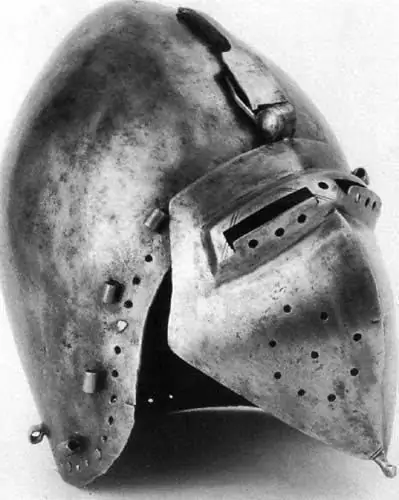
On many helmets, for example, as on this one (Museum of Valerie Castle in Switzerland), the aventail could be removed, for which appropriate fasteners were provided along the edge of the helmet. It is not known whether there was also a chain mail hood under the helmet. But a quilted cap was, of course, a must.
Miniatures, effigies and artifacts that have survived to this day make it possible to fairly accurately reproduce the appearance of the warriors of the mid-14th century, that is, the era of "mixed armor". Perhaps the best depiction of the knights of this period, and in detail, was made by the famous British artist Graham Turner. In his drawing, firstly, there is an image of all types of helmets used at that time, including the "shadow cut", and secondly, the multi-layered protective clothing that became typical for this era.
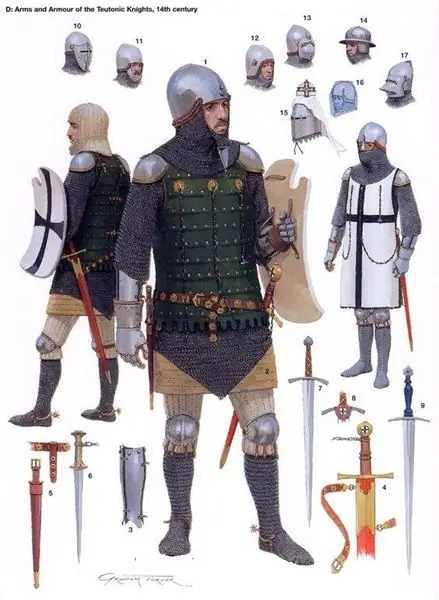
Graham Turner. Knights of the Teutonic Order of the middle of the XIV century.
This image is confirmed by numerous finds in a burial at the site of the Battle of Visby in 1361, which became a valuable source of our information about the defensive weapons of that time. By the way, the shape of the sword has changed accordingly. From a purely chopping weapon, it turned into a chopping-stabbing one. An important addition to it was the dagger, which had practically never been seen on the same effigies.
Again, we emphasize that in different places this process proceeded with varying intensity and had its own specific features, dictated not so much by practical expediency as by the same fashion.

William Fitzralf, 1323 Pembrash. As you can see, the effigy of Pieter de Grandissant is 30 years older than this. That is, for that time, the period is very long. But there is no difference between them, and which one is older and which one is younger is simply impossible to say.

Thomas Kain, 1374 Here, the 50-year difference is clearly visible. First of all, the long-legged surcoat was replaced by a short jupon. Then we see that the armor covering the legs has become more perfect. Now these are not strips of metal attached to the chain mail, or on top of it, but anatomically made all-metal armor. But here's what is surprising: the aventail, attached to the bascinet's helmet, has not undergone the slightest change.

And here is another effigy belonging to Richard Pembridge of Hereford Cathedral in 1375. Both are practically identical, and we can find many more very similar effigies.
That is, from the beginning of the XIV century until its last quarter, noticeable changes took place in the knightly armament of Western Europe. But they mainly touched on the covers for the legs, then on cash clothing (!), The protective devices for the hands changed slightly, it is difficult to say anything about the torso, since it is covered by fabric, the helmets have not changed and the aventail has not changed. The conclusion suggests itself that, judging by how the process of improving the means of protection went, the most vulnerable of the knights were the legs. But the neck … the neck was protected "according to the residual principle." That is, purely theoretical conversations about what a knight could have been hooked with a spear with a hook for the aventail, or that the enemy's spear could have gotten here during an equestrian clash, do not matter. Rather, they did not. All this is purely speculative modern theorizing, not based on anything other than formal logic. Oh, this logic, alas, fails us very often.
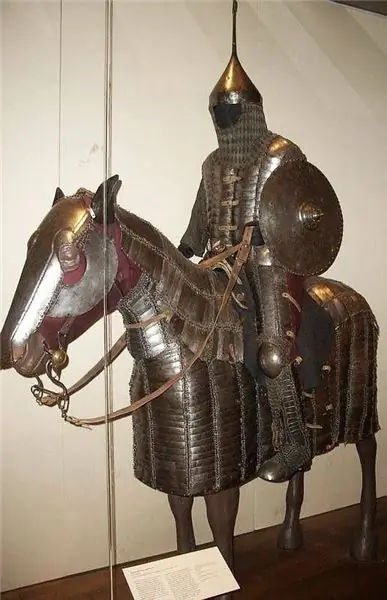
Before us is the rider of the Timurid cavalry 1370 - 1506. from the Metropolitan Museum of Art in New York.
For comparison, let us turn to the "knights of the East". How do they differ from their "fellow craftsmen" depicted in the above effigies? By and large, nothing but the spire on the helmet. On it, there is also an impressive volume of the aventail, so that nothing seems to prevent the spear from hitting this very place. But … something, apparently, prevented from doing this both in the East and in the West, if it was this part of the knight's armor that changed most slowly.

1401 Thomas Beauchamp breaststroke from Warwick Church.
Let's skip another quarter of a century and turn to the tombstone brass plate, that is, the breaststroke of 1400. This is Thomas Beauchamp's 1401 breaststroke from Warwick Church. However, this choice in this case is completely random, since the effigy of von Totenheim from Germany (1400), Grunsfeld looks similarly; Hugh Newmarsh (1400), Watton on Valais (UK); Edmund Peacock breaststroke (1400), St. Albans: Thomas de Freuville (1400) - couples with his wife, from Little Shelford and many, many others.
On all of them we see perfectly rendered "anatomical figures" of knights "chained in metal" and … having a chain mail aventail around their necks! Actually, it remained the only piece of chain mail armor available to our eyes. Everything else is solid forged metal plates!

The bras of Nicholas Hauberk (1407) from Cobham looks exactly the same. Edmund Cockayne (1412), from the Church of St. Oswald in Ashborn - likewise, the effigy of Georg von Bach (1415), the church of St. Jacob in Steinbach (Germany) - in a similar way, and only the effigy of Nicholas Longford (see photo above) from 1416 from the church in Longford shows us a neck cover made of metal! But again, this cannot be proved with absolute certainty. It is quite possible that his chain mail aventail is just covering … an ordinary cloth!
It took almost 80 more years for the chain mail to be removed under the metal armor, and the throat cover became all-metal.
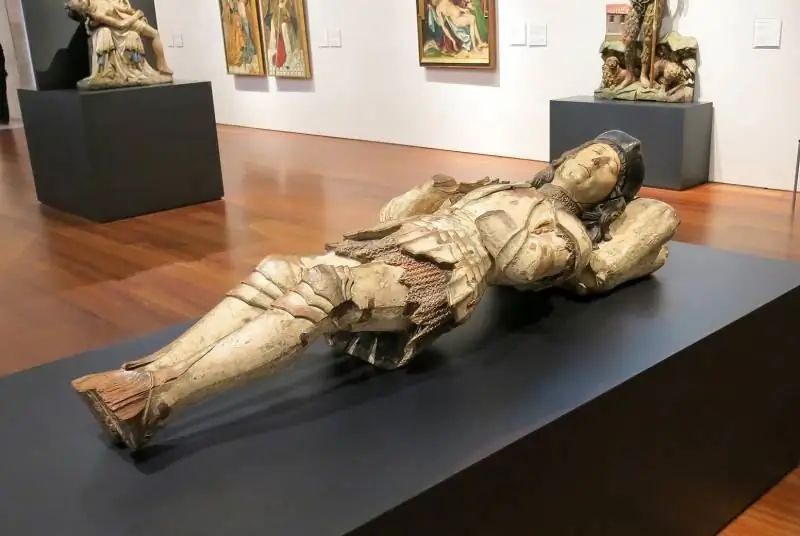
An interesting example of such armor is shown to us by the effigy of Don Luis Paquejo in 1497 from the museum in Valladolid.

The effigy of don Luis Paquejo 1497. Valladolid Museum.
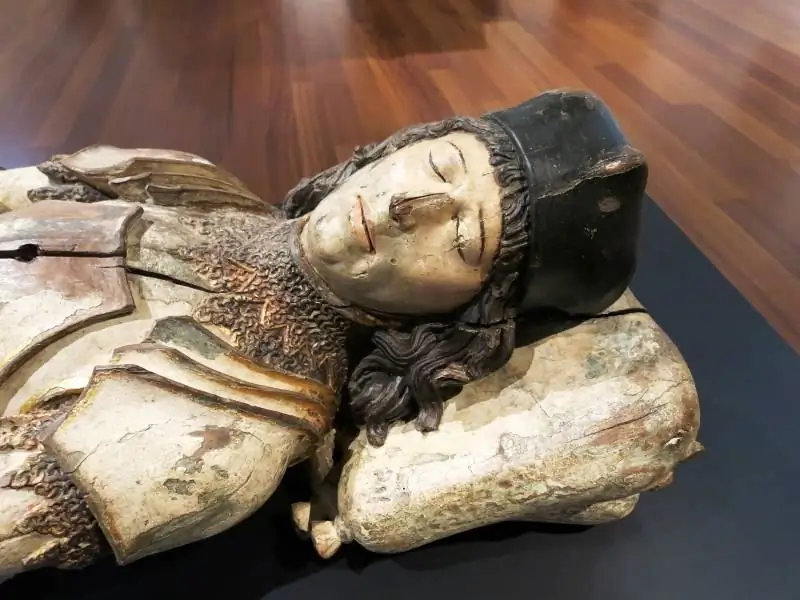
And this collar, as we can see, is two-layer!
It clearly shows that a collar is made of chain mail fabric in them, it is used in his armor as a decorative trim of the shoulder pads and a "skirt" below the plate legguards, which, in principle, could well be abandoned.
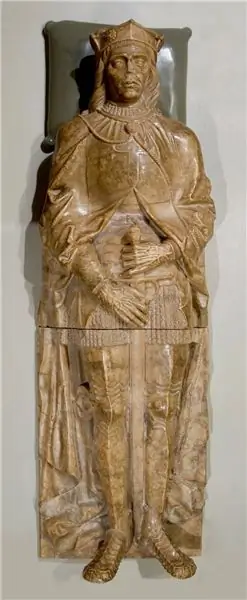
An alabaster effigy depicting a knight of the Order of Santiago de Campostella (c. 1510-1520). Los Angeles County Museum of Art.
It is interesting that on this, already quite late effigy, we still see a chain mail collar and a chain mail, completely unnecessary "skirt". In principle, this may indicate two circumstances. The first is that the armor is old, that is, they are many years old and the innovations of the armor craft simply did not touch them. The second is local traditions. Let's say that it was in Spain that “it was so accepted” and that they put up with it, so as not to stand out from others.
Surprisingly, even in the 15th century - that is, in the "era of all-metal armor" with fully forged armor, the chain mail necklace was still used! For example, this is very clearly demonstrated to us by the armor of Matches the German of 1485-1505. from Landshut. Most likely they cannot be called typical. But they were. As well as armor with a plate neck cover attached to the bottom of the helmet.
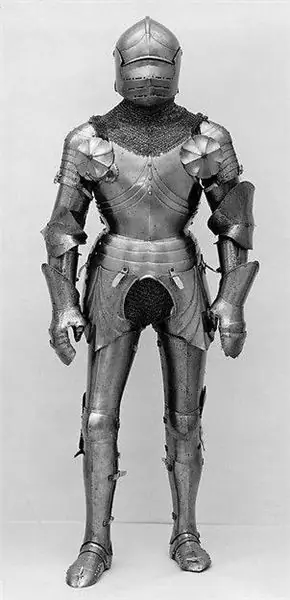
Armor 1485 - 1505 Weight 18.94 kg. (Metropolitan Museum of Art, New York)
That is, continuing to study effigies, braces and artifacts that have come down to us, we can reasonably conclude that the chain mail aventail was used for a very long time, until the 16th century, and finally disappeared only with the appearance of a metal "necklace" protecting the throat by 1530 knight. And it was around this time that they began to connect it to the armé helmet. The lower edge of the armé was forged in the form of a hollow cord, and the upper edge of the necklace was made in the form of a protruding roller, into which it entered. Thus, they mated with each other. Such helmets became known as the Burgundy Arme or Burgonet.
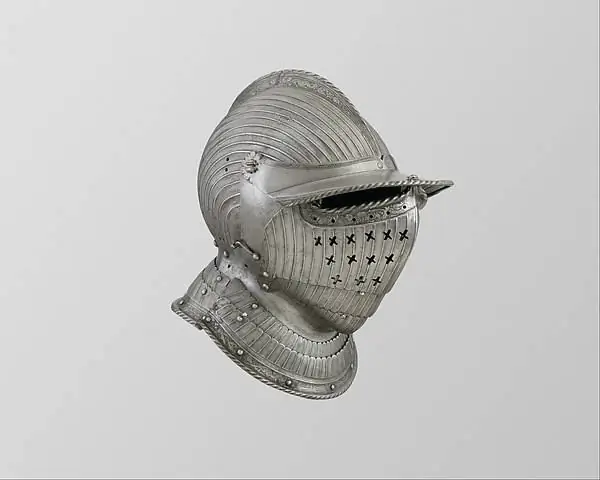
Burgonet. Augsburg 1525 - 1530 Weight 3004 (Metropolitan Museum of Art, New York)
Later, the lower edge of the arme began to turn into a movable necklace, without rigid fastening. Thus, the knight could now turn his head no worse than an infantryman, that is, the neck was completely protected from blows both from the front and from the back. Chain mail was completely abandoned in the 17th century, as the cuirassier armor of this time demonstrates to us.

Cuirassier armor 1610 - 1630 Weight 39.24 kg. Milan, Brescia. (Metropolitan Museum of Art, New York)
Finally, it should be remembered about such a form of throat cover as the tournament "toad helmet". In fact, this entire helmet was an upwardly developed throat cover, which was very firmly fastened to the cuirass. The calculation was made precisely for a blow to the throat with a spear, which, in fact, did not even try to repel! But … a tournament is still not a war, and there were rules and specific weapons.
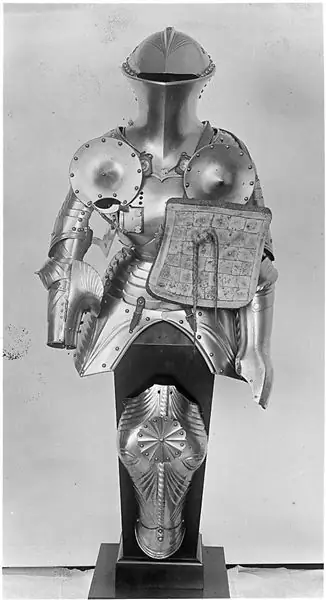
Tournament armor. (Metropolitan Museum of Art, New York)






